All plants thrive when given fertilizer. Pond plants aren't any different than our garden plants and flowers. A little tip for your water hyacinths is to take them out of your pond and place them in a tub with water and miracle grow in it. Leave them soak for awhile soaking up the fertilizing in their leaves. Rinse them off and return them to your pond. They will flower more for you. You can also do this when you first receive your plants when re-hydrating them prior to planting them or placing them in your pond.
There are five different types of plants that you will want to add to your pond to provide beauty and help you achieve an ecological balance in your water garden.
Submerged plants such as Anacharis, Vallisneria, Cabomba, Hornwort and Red Ludwigia remove nutrients from the water so algae can’t thrive. Submerged plants do not need soil. Just plant them in one-gallon pots or plant baskets filled with pea gravel and place them in the bottom of your pond. Or purchase plant anchors with your plant order, and simply wrap the weights around the bunch of plants and they will sink to the bottom of the pond.
Water Hyacinth, Water Lettuce, Frog Bit, Parrot’s Feather and Azolla are all members of the floating plant family. Floating plants are very useful in keeping the pond water clean and clear. These are simple plants that free-float and do not need to be potted. You simply toss them into the water garden where they are extremely beneficial to the pond. Floating plants shade the surface and with their roots dangling in the water they pull nutrients from the water essentially starving the algae. They tend to be quite prolific and provide hiding places for baby fish and other water garden inhabitants.
Otherwise known as water lilies, they grow in pots placed 12 to 36 inches deep and have foliage and flowers that bloom on top of the water’s surface. Water lilies provide shade for the fish and add coverage to the water’s surface. Water lilies are available in many different colors and sizes.
Lotus are also considered a hardy water plant that can also be planted deep in your pond and its flowers and leaves will help provide shade and coverage.
Plants such as the hardy canna (Thalia dealbata) grow in mud or 8 to 12 inches deep in the water. Arrange them on platform shelves on the edge of your pond to conceal the water garden’s artificial edges. Plant bog and marginal plants in plastic pots, then place the pot under the water and let the plants grow in the open air. When the plants are young, use care and gradually lower them deeper as the plant matures.
Bog Plants and Marginal Plants
Marginal and bog plants grow in damp soil just outside a pond. They are good transition plants between land and water. Some tolerate completely waterlogged ground and others will not tolerate more than moist soil, check each plant’s requirements carefully.
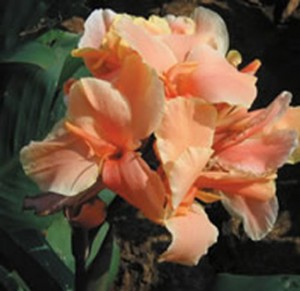 Tropical Sunrise Canna is one of the showiest cannas I've seen. New this year for us it produces large apricot and pink blooms. It has deep green foliage and grows to about 3 feet tall. It is an early bloomer and will continue to bloom throughout the season. Cannas are considered tropical and need to be dug up in late fall after the first frost in northern climates. You can store the tubers in lightly moistened peat and replant the following season.
Tropical Sunrise Canna is one of the showiest cannas I've seen. New this year for us it produces large apricot and pink blooms. It has deep green foliage and grows to about 3 feet tall. It is an early bloomer and will continue to bloom throughout the season. Cannas are considered tropical and need to be dug up in late fall after the first frost in northern climates. You can store the tubers in lightly moistened peat and replant the following season.
I just wanted to let you know that I have already received my Louisiana Irises and they look great. The roots are still wet and the plants are green and healthy. I have already planted them and it is so nice to have a good 12" of growth right out of the box.
Thank you
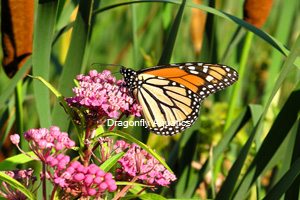 Attracting butterflies to your backyard water feature is easy. It's another one of life's simple pleasures that all gardeners enjoy. Some of the plants that will attract butterflies to your pond are:
Attracting butterflies to your backyard water feature is easy. It's another one of life's simple pleasures that all gardeners enjoy. Some of the plants that will attract butterflies to your pond are:
"Habitat loss is the leading cause of species endangerment and extinction. Backyards are now playing an important role in wildlife conservation. You can help to reduce the negative effects of habitat loss by landscaping with native plants and turning your backyard into a wildlife oasis."
A wildlife-friendly landscape is composed of four essential items:
1) Food 2) Water 3) Shelter or Cover 4) A Place to Raise Young
Creating a habitat in your own backyard is easy. "Choose native plants to your area, both surrounding your pond and in the pond. Explore a nearby wetland to familiarize yourself with its environmental conditions and plant diversity - the goal is to mimic a natural area. To provide the best habitat for a variety of wildlife, choose trees, shrubs, and herbaceous plants with different attributes. When selecting plants, choose varieties that will provide resources and shelter at different times of the year."
Water gardens are a natural place for attracting butterflies. Butterflies will first be attracted to your pond by the flowering bog plants, sip on the nectar and then perch on moist rocks and mossy areas to get a drink. I could spend hours on my bench by my pond, watching the different species fluttering about. If only I had more time to do so!
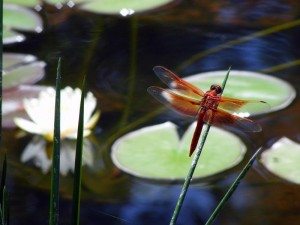 This picture was sent to us from a customer. It would only make sense that we would have a lot of pictures of Dragonflies. Dragonflies, I believe bring good luck. They are a symbol of transformation and life's ever-constant process of change. Change.....we seem to be hearing that a lot lately. I could spend hours sitting by my pond watching dragonflies, as they are so amazing, how quickly they can land in on a pond plant, change flight patterns and sparkle in the sunlight.
This picture was sent to us from a customer. It would only make sense that we would have a lot of pictures of Dragonflies. Dragonflies, I believe bring good luck. They are a symbol of transformation and life's ever-constant process of change. Change.....we seem to be hearing that a lot lately. I could spend hours sitting by my pond watching dragonflies, as they are so amazing, how quickly they can land in on a pond plant, change flight patterns and sparkle in the sunlight.
Dragonflies are usually always found around your pond eating small insects and mosquitoes helping to control the population of harmful insects. Their larvae, known as "nymphs" are aquatic.
Plants that one may put in their water feature to attract dragonflies and damselflies would be rushes and sedges that rise up above the water surface, that provide a perch for them. Horsetail rush, cattails, zebratails and other long stemmed sedges and rushes are good for this. Try to keep them away from fast moving water or waterfalls. They prefer calming waters. These type of plants also give the juveniles a place to crawl up when they emerge from the water. By putting other water plants such as marsh marigolds, ludwigia, arrowheads, and irises etc. it gives them a place to lay their eggs. Lay some bright colored flat rocks around the edges of your pond for the dragonflies and damselflies to sit on. To encourage them to hang around your water garden try planting other wildflowers around your pond. You'll not only attract dragonflies but will also attract butterflies and hummingbirds.
We chose the name Dragonfly Aquatics because of the beauty and symbolism of the dragonfly. What better way to describe the enjoyment one gets from their water garden.
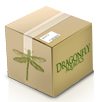 When you receive pond plants by mail order they don't always appear as lush plants having used their stored moisture during shipping. For this reason we recommend the following.
When you receive pond plants by mail order they don't always appear as lush plants having used their stored moisture during shipping. For this reason we recommend the following.
Remove the pond plants from their bags and place them in some water (65-70 degrees) in the shade. This will allow the plants to replenish moisture that may have been lost during shipment. Your plants may be kept in the house in a container for a day or two before planting if necessary. Any floating plant or underwater plant can be put in your pond after the sun goes down the first day that you receive them. Make sure the pond plants stay damp and in the shade prior to being placed in the pond.
Many of our plants are shipped directly from a greenhouse environment. Just like any plant coming out of a greenhouse it needs time to adjust to its new environment outside with the direct sun and wind. This process is often referred to as "hardening off".
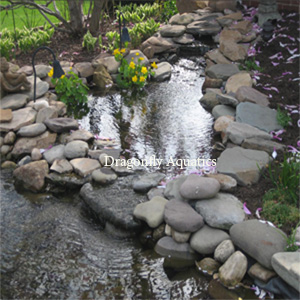 You can add a bog to your existing pond easily. Select a location around your pond, preferably an area that is higher than your existing pond. Dig up a small area the depth and shape you like and put down a piece of liner. You can create a small waterfalls by placing a small pump in your pond and circulate the water from the pond up to the top of the bog area. The hose was attached to the pump in the pond and then brought up the side of the bog area and buried in the dirt. At the top of the bog the hose was clamped to create a small return of water into the bog and covered with rocks. The edges of the liner were covered with rocks.
You can add a bog to your existing pond easily. Select a location around your pond, preferably an area that is higher than your existing pond. Dig up a small area the depth and shape you like and put down a piece of liner. You can create a small waterfalls by placing a small pump in your pond and circulate the water from the pond up to the top of the bog area. The hose was attached to the pump in the pond and then brought up the side of the bog area and buried in the dirt. At the top of the bog the hose was clamped to create a small return of water into the bog and covered with rocks. The edges of the liner were covered with rocks.
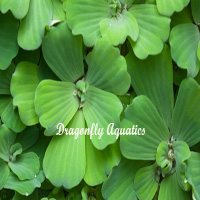 Water Lettuce (Pistia stratiotes), a floating plant that creates a natural filter in your pond while helping to combat algae and green water. Water lettuce grows like a rosette from a single crown resembling a head of lettuce. Each leaf may reach up to 12 inches in height and several inches wide and can reach 24 inches in diameter. They grow best in partial shade, especially in the hotter climates and can tolerate full shade. Water Lettuce will not tolerate cold water. It prefers water temperatures of 6o degrees and above. If you experience a late Spring freeze in your area, you should protect your Water Lettuce from the cold, by bringing it indoors during the cold spell.
Water Lettuce (Pistia stratiotes), a floating plant that creates a natural filter in your pond while helping to combat algae and green water. Water lettuce grows like a rosette from a single crown resembling a head of lettuce. Each leaf may reach up to 12 inches in height and several inches wide and can reach 24 inches in diameter. They grow best in partial shade, especially in the hotter climates and can tolerate full shade. Water Lettuce will not tolerate cold water. It prefers water temperatures of 6o degrees and above. If you experience a late Spring freeze in your area, you should protect your Water Lettuce from the cold, by bringing it indoors during the cold spell.
Buy water lettuce-pond plants here.
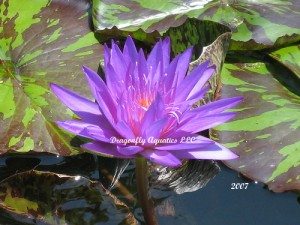 Thought I would share some pictures periodically taken from my pond and my sisters. We enjoy sharing our pictures and seeing pictures of other ponds and pond plants.
Thought I would share some pictures periodically taken from my pond and my sisters. We enjoy sharing our pictures and seeing pictures of other ponds and pond plants.